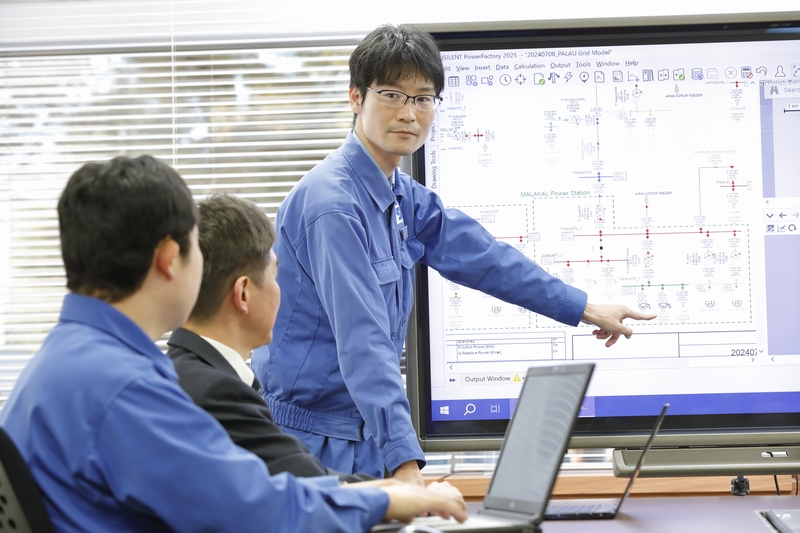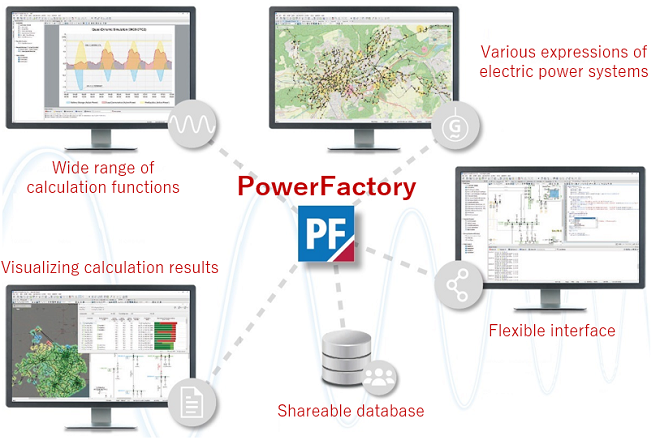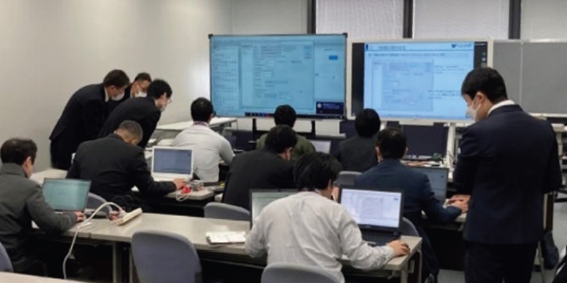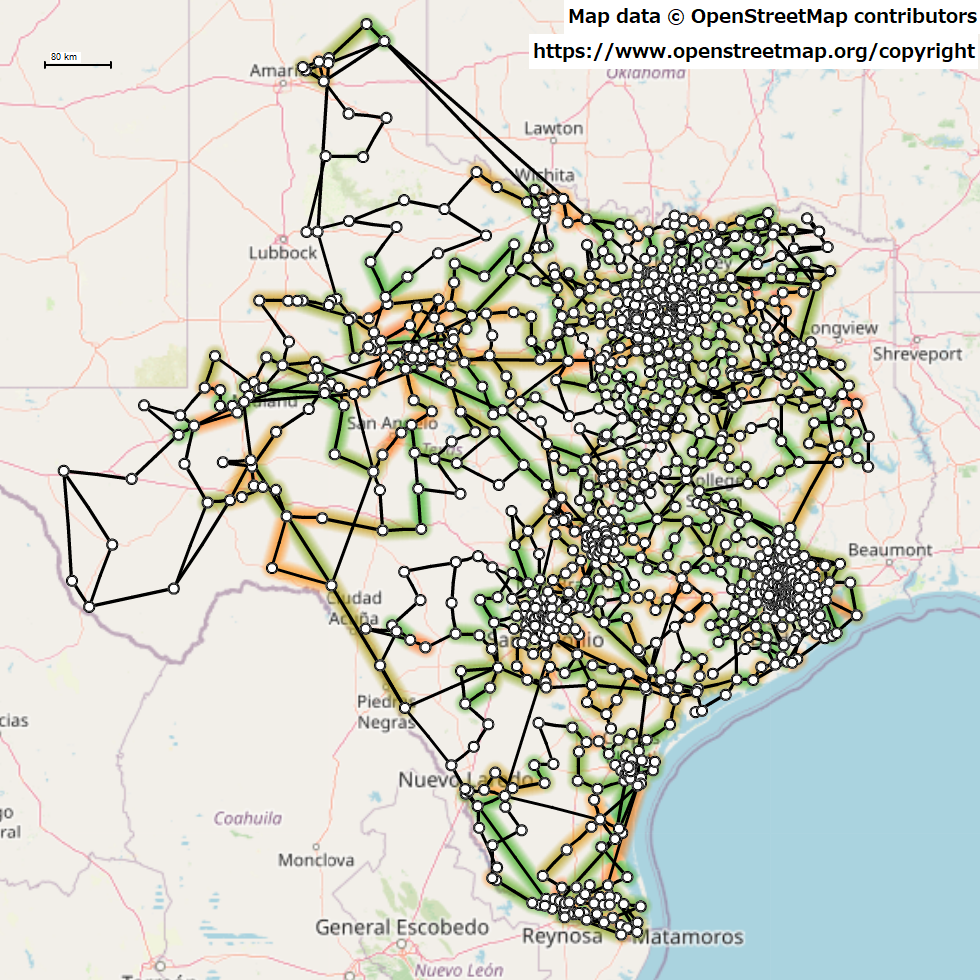PowerFactory—analytic technology underpinning the stable supply of electric power
- Keiichi Sato
- Yusuke Mori
- Yusuke Yamashita

In Japan, the retail business of electric power became fully liberalized in 2016. Retail operators not only sell electricity but must also balance demand and supply as they relate to the electric power system (electric power grid from the power plant to the delivery of electricity to customers) to enable customers to reliably use electricity. In addition, renewable energy continues to be introduced through efforts to become carbon neutral by 2050, which is making it more difficult to maintain a balance between demand and supply. Thus, the need to engage in visualization to ascertain the flow of electricity through an electric power system is growing. Consequently, analytic software for electric power systems will play a role.
Analytic software for electric power systems is useful for operation of electric power systems because, in addition to situations in the event of an electric power system accident, it can analyze fluctuations in the demand and supply of electric power and the impact of changes in the power supply configuration on an electric power system and make predictions accordingly.
Takaoka Toko is the exclusive dealer for PowerFactory, analytic software for electric power systems developed and provided by DIgSILENT of Germany, and handles both sales and consulting services in Japan.
Technology
PowerFactory, analytic software for electric power systems that “visualize” electricity
PowerFactory allows the addition of optional functions to the slate of basic functions according to the needs and requirements of each user. Developed by Germany’s DIgSILENT, the software has been widely adopted by countries around the world to contribute to the stable supply of electric power. For example, the software not only provides the basic functions of load flow analyses and short-circuit analyses but also offers a wealth of optional functions that can be used to perform stability analyses (RMS) and electromagnetic transients (EMT) in anticipation of potential accidents to the electric power system as well as numerical analyses and so much more, which makes the software useful for studying the introduction of renewable energy systems.
In particular, PowerFactory includes an entire suite of elements capable of supporting users through the deployment of an extensive technical documentations amassed in the course of building a track record of resolving issues in Europe, a region that leads in the area of renewable energy, as well as functions for visualizing the status of an electric power system, and support for inquiries.

Profile
-
 Keiichi SatoGX Solution Business Division
Keiichi SatoGX Solution Business Division -
 Yusuke MoriStrategic Technology Institute
Yusuke MoriStrategic Technology Institute
Research & Development Center
Computer Analysis & High Power Testing Group -
 Yusuke YamashitaGX Solution Business Division
Yusuke YamashitaGX Solution Business Division
Business Development Promotion Office
Grid Innovation Advancement Group
Deployment in Japan of a system analysis tool with a rich overseas track record
SatoThe mission of the GX Solutions Business Division, which is the section to which I am assigned, is to develop new business operations. We began handling PowerFactory as a commercial product in fiscal year 2021. I am in overall charge of both sales and technology for this product.
MoriI am assigned to the Strategic Technology Institute and am involved in developing many different kinds of computer-based simulation technologies. As part of my work, I have been analyzing electric power systems and have been learning about the analysis of electric power systems using PowerFactory since fiscal year 2021.
YamashitaI am assigned to the Business Development Promotion Office of the GX Solutions Business Division. I am involved in developing business operations related to distributed power control and voltage control in the distribution lines of electric power systems. As part of my work, I have begun working with PowerFactory in the course of operations using tools for analyzing grids. I began learning how to use PowerFactory on a full-fledged basis in fiscal year 2021.

SatoFollowing the full liberalization of the electricity retail market in 2016, the number of new retail operators in Japan increased. This led to a surge in demand for power system analysis software. These new retail operators needed to ascertain the state of electric power systems in order to use existing electric power systems to provide customers with electricity. For this reason, analytic software for electric power systems became useful.
In searching for analytic software for electric power systems to meet the needs of customers, we came across PowerFactory, which was developed by Germany’s DIgSILENT. DIgSILENT was also looking to select one company with knowledge of electric power systems as its distributor; we managed to step up to the plate and become the exclusive distributor of PowerFactory in Japan in 2021.
MoriIn recent years, problems related to the power system seem to have become more sophisticated and complex because of a variety of different factors—changes in various rules, the increase in renewable energy, and the emergence of such unconventional modes of use as micro-grids and off-grid systems. To address these issues, we began to work on acquiring analytic technology based on the use of PowerFactory, which offers an extensive suite of functions. PowerFactory is characterized by the fact that it encompasses not only the analysis of phenomena that take place over short time periods, such as electromagnetic transients (EMT), but also the analysis of more longer-term phenomena. In addition to its basic functions, this software is great in that it allows users to add analytic options according to their needs.
SatoAnother feature of this software is that its application programming interface, or API, is published, which means that it offers an excellent connection with external systems and devices. For instance, the software can connect with large facilities such as factories and with infrastructure monitoring and control systems to obtain data from measurement instruments and information on the on/off status of circuit breakers. This in turn allows actual system information to be used on an as-is basis for analysis and control purposes, which makes it exceedingly useful.
YamashitaLet’s look at a specific example. With many tools, you will often need to first output results to a CSV file, graph this in Excel, and then repeat this process several times again in order to check the calculation results after an analysis has been performed. With PowerFactory, however, you can overlay analytic results on a wide variety of graphs and system diagrams. This helps since analytic results that can be difficult to decipher at a glance can be organized with ease. In addition, the software not only allows you to create basic graphs consisting of time series plots and scatter plots but also graphs specific to the electric power sector without much effort, including those that depict voltage fluctuation profiles, vector diagrams, and the operating characteristics of protection relays. This in turn streamlines the process by which analytic results can be grasped.
Mori It has a wide range of samples to help users understand situations the flow of electricity through an electric power system, so I feel it is an easy-to-use tool that can visualize invisible electricity.

Transition from selling goods to selling services
SatoFirst, we began by holding study sessions across departments in order to deepen the knowledge of PowerFactory within the company. We have them use PowerFactory positively in their regular work, and we continue to exchange information while receiving feedback from each department.
MoriThere are several different types of grid analysis tools. I have been involved in electromagnetic transients (EMT) for some time now. With PowerFactory, I first started learning with electromagnetic transients (EMT) but there are also analyses that will need to be performed as renewable energy grows in popularity. Among them is the quasi-dynamic simulation (medium to long-term load flow analysis). For this type of analysis, you calculate renewable energy output or the amount of electricity used, which changes over time, or perform other complex calculation to determine whether the balance between the supply and demand for electricity can be maintained. I have been studying these kinds of analyses where I lack experience by consulting with Mr. Sato and attending in-house study sessions.
We found that a convenient aspect of dealing with PowerFactory was the way the characteristics of electric power equipment actually in circulation are registered, which makes it possible to perform system analyses that reflect the characteristics of many different kinds of devices and equipment. The software also offers the convenience of being able to easily create a model by selecting the equipment a user is using.
Sato PowerFactory’s solid support is also praised by its users. Technical materials are fully open to the public, and extensive manuals, materials for tutorials, technical references with the formulas needed for analyses, explanations provided through streamed videos, and so much more are available. You can obtain answers to questions submitted via a support chat in about one business day.
MoriOnce a year, PowerFactory undergoes a major version upgrade along with updates to the manuals. Customer problems collected by support are addressed in the following year’s version upgrade.
SatoAs the exclusive dealer for this product in Japan, I collaborated with Mr. Mori and Mr. Yamashita to produce a Japanese-language version of the operating manual in response to user demand. As part of our consulting services, we held a PowerFactory operation information session for our customers using this operation manual.

SatoPowerFactory is also being used in joint research between our company and universities. Because the software is a standard analytic tool overseas, using PowerFactory when presenting papers overseas is advantageous because it offers greater reproducibility and reliability. In addition, the clear visual display of calculation results makes it easier to understand complex electric power system technology and terminology in a more accessible way.
YamashitaPowerFactory offers a much more extensive range of graphical elements than other tools and can even allow you to present calculation results with colorful gradients. You can also display analytic results that are fully linked to map data. PowerFactory is great in that you can present analyses in completely novel ways, such as by showing results in a way that looks like a map of rail lines and or a topographical map of an area.

YamashitaGrid models are essentially produced in the same way irrespective of the type of analysis. Once this way is learned, the model can be derived and applied to different types of analyses, and the versatility of its use is certainly one reason for the worldwide use of this software. Depending on the purpose at hand, users can, for example, create their own control systems or model calculation and processing algorithms, such that this is also a tool that is compatible with research by universities from the standpoint of the elements of novelty and originality that are required for proper research.
Helping to build stable electric power systems while overcoming numerous obstacles
SatoBecause this software has been in use overseas, our consulting business overseas is ahead of where it is at here in Japan. Since we cannot interfere in markets controlled by overseas distributors, we ask local distributors to handle the version upgrades made to PowerFactory and then engage only in consulting operations.
In order to further spread of PowerFactory in Japan, we would like to target renewable energy operators and electric power companies. However, Japanese electric power companies commonly use electric power system analytic software provided by domestic research institutes, such that a foreign product would need to clear a high hurdle to be adopted. While PowerFactory was finally introduced to an electric power company for the first time in 2022, we feel that there is great potential for more widespread adoption given the substantial attention it has drawn for its ease of use.
MoriWe would like to help build stable electric power systems by harnessing PowerFactory. We hope to steadily acquire the elemental technologies needed to attain this goal.
YamashitaPrecisely because this software comes with a variety of functions, I will endeavor to figure out its overall functionality as the person in charge of handling technologies for the company, even though it may be difficult to take advantage of all of them at once. In particular, I am committed to facilitating the more practical use of links between PowerFactory and external systems (such as systems for monitoring and controlling facilities and infrastructure and analytic software other than PowerFactory). I would like to look for effective ways to use this software while sharing information with each department within the company and ultimately, through consulting activities, provide users with the knowledge we acquire.
SatoWe are the only distributor that is entitled to sell and provide consulting services for PowerFactory in Japan. We would like to continue to fortify our in-house system for selling PowerFactory and, in the next step, expand consulting operations to properly accommodate the needs of our customers.

Latest articles
-
 interviewDevelopment of a fault section detection system that enables rapid power restorationElectricity is essential in our lives. A number of substations through which electricity is provided from a power station to houses have a key role in the stable delivery of power.
interviewDevelopment of a fault section detection system that enables rapid power restorationElectricity is essential in our lives. A number of substations through which electricity is provided from a power station to houses have a key role in the stable delivery of power. -
 interviewPowerFactory—analytic technology underpinning the stable supply of electric powerIn Japan, the retail business of electric power became fully liberalized in 2016. Retail operators not only sell electricity but must also balance demand and supply as they relate to the electric power system (electric power grid from the power plant to the delivery of electricity to customers) to enable customers to reliably use electricity. In addition, renewable energy continues to be introduced through efforts to become carbon neutral by 2050, which is making it more difficult to maintain a balance between demand and supply. Thus, the need to engage in visualization to ascertain the flow of electricity through an electric power system is growing. Consequently, analytic software for electric power systems will play a role.
interviewPowerFactory—analytic technology underpinning the stable supply of electric powerIn Japan, the retail business of electric power became fully liberalized in 2016. Retail operators not only sell electricity but must also balance demand and supply as they relate to the electric power system (electric power grid from the power plant to the delivery of electricity to customers) to enable customers to reliably use electricity. In addition, renewable energy continues to be introduced through efforts to become carbon neutral by 2050, which is making it more difficult to maintain a balance between demand and supply. Thus, the need to engage in visualization to ascertain the flow of electricity through an electric power system is growing. Consequently, analytic software for electric power systems will play a role. -
 interviewEV charging in the interval between errands. aima CHARGEWith the aim of carbon neutrality, Japan set the goal to achieve 100 percent electrified vehicles in new passenger car sales by 2035. The proliferation and expansion of the EV charging infrastructure is essential for the proliferation of electric vehicles (hereinafter referred to as “EV”), and the Ministry of Economy, Trade and Industry set the goal of building 300,000 EV charging equipment by 2030.
interviewEV charging in the interval between errands. aima CHARGEWith the aim of carbon neutrality, Japan set the goal to achieve 100 percent electrified vehicles in new passenger car sales by 2035. The proliferation and expansion of the EV charging infrastructure is essential for the proliferation of electric vehicles (hereinafter referred to as “EV”), and the Ministry of Economy, Trade and Industry set the goal of building 300,000 EV charging equipment by 2030. -
 interviewProposal for new value via the first steel-tower-type full-color rendering illumination in JapanSince July in 2021, Prifoods Stadium in Hachinohe City, Aomori Prefecture has operated LED illumination equipment capable of the first steel-tower-type full-color light rendering in Japan. Takaoka Toko/Kyoya Denki/CADEC specific construction work consortium accepted an order for this equipment from Hachinohe City, and it was completed after nine months of work.
interviewProposal for new value via the first steel-tower-type full-color rendering illumination in JapanSince July in 2021, Prifoods Stadium in Hachinohe City, Aomori Prefecture has operated LED illumination equipment capable of the first steel-tower-type full-color light rendering in Japan. Takaoka Toko/Kyoya Denki/CADEC specific construction work consortium accepted an order for this equipment from Hachinohe City, and it was completed after nine months of work.
